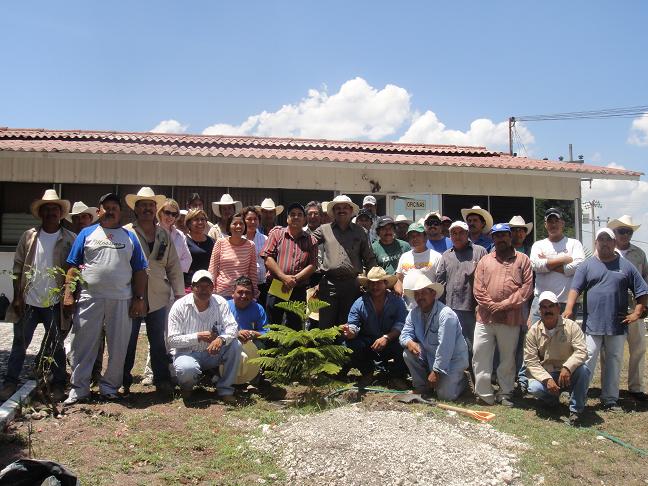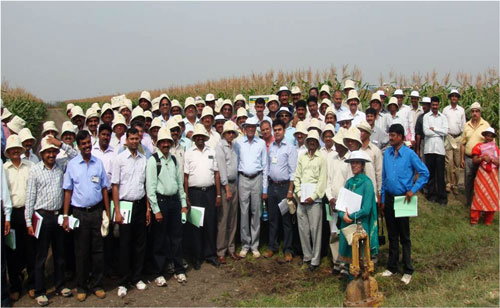Conservation agriculture (CA) continues to take root in Mexican fields, and CIMMYT’s CA team is helping it flourish by providing training and technological support to farmers. Examples of this are three CA events that took place in mid-March at El Batán and at Guasave, Sinaloa, Mexico.
On 18 March, 27 technicians and farmers from Apan, Hidalgo, visited El Batán. Apan is a rainfed location where 90% of the land is sown with barley; the remaining 10% is sown with diverse crops (maize, beans, cowpea, potato, and oat). Andrea Chocobar and José Luis Salgado, from the Mexico-based CA program, and Francisco Magallanes, El Batán superintendent, hosted the group.
The visit originated from a request by Joaquín Pérez Aguirre, who is the general manager of a consultant agricultural services bureau and a farmer. Aguirre asked Dagoberto Flores, a member of the CA team, and Salgado to help train fellow farmers on CA practices. Aguirre has collaborated with Flores before, and both agreed that because a CA demonstration plot will soon be established in Apan, it is important to train local farmers, especially on how to calibrate seeders and fumigation equipment. The pending demonstration plot is part of the project “CA hub for small grain cereals in the highlands of Mexico,” which is a collaborative project with the Mexican Agriculture Ministry.
“Most of my colleagues had heard about CIMMYT, but it wasn’t very clear for them what CIMMYT was or did. Today, especially after the introduction by Andrea Chocobar, everybody is very impressed with what you do here,” said Aguirre, who led the group of visiting farmers. “I’ve worked 28 years in agriculture, and have seen programs start and conclude, and a lot of money invested, but in the end, not many outputs. I want to implement a different approach not just focused on keeping knowledge in your head, but on applying it in the field.”
After the field day, at least one farmer was convinced that he wants to apply CA to his field. “I want to learn more about the (CA) technology for the benefits it offers, such as less cost and more productivity,” said Felipe Vera Herrera, of Chimalpa, Hidago. “I’m going to tell my neighbors about the visit, but most of all, I will put into practice what I learned here today so they can see that CA is profitable.”
The following day, Friday 19 March, CA team members Bram Govaerts and Jesús Mendoza met with 10 representatives of the Farmer Association of West River Sinaloa (AARSP) for breakfast in Guasave, Sinaloa. This was followed by a CA course for 15 leading farmers and technicians from AARSP and the seed company subsidiary ASGROW. The course took place at the Experiment Station Miguel Leysón Pérez, and was part of the “CA hub for the irrigated zone of the Pacific,” and in collaboration with ASGROW.
The most recent CA event took place on Monday 22 March. A group of nearly 50 agronomic engineering students from the Universidad Autónoma Metropolitana (UAM) in Mexico City visited El Batán. They were accompanied by professors Mariela Fuentes and Manuel Tarín Ramírez. The visit included an explanation of CIMMYT and CA, and a visit to the long-term CA trial at lot D-5. In the field, Chocobar and Mariela Fuentes explained plot management and answered questions from students. The students also saw a demonstration of a multi-use-multi-purpose machine and of a manual seeder, and toured the germplasm bank.
“A visit like this broadens our perspectives because we can see that there are new technologies that could be used in Mexico,” said Aarón Torres López, one of the visiting students. “I decided to study agronomic engineering because I would like to make a difference in my country. I hope my fellow agronomy students also want to change things in the crop fields.” These three events and other activities focused on the development and dissemination of CA in Mexico are part of a global program and strategy to foster the adoption and use of more productive and sustainable practices for crop management. Additionally, the CA team would like to thank Scott Ferguson for arranging free child care at CENDI for famers who brought their children with them to the field training event at El Batán.
 “I am very impressed with the level of commitment and professionalism shown by the different groups working at Agua Fría and how the trials were being managed,” Prasanna told Agua Fría staff.
“I am very impressed with the level of commitment and professionalism shown by the different groups working at Agua Fría and how the trials were being managed,” Prasanna told Agua Fría staff.